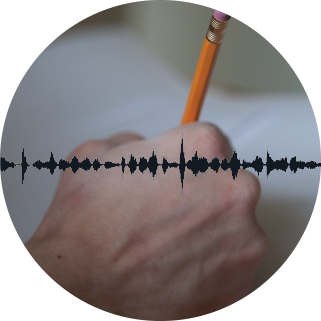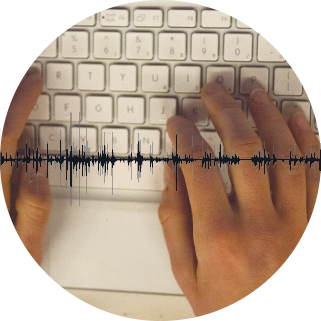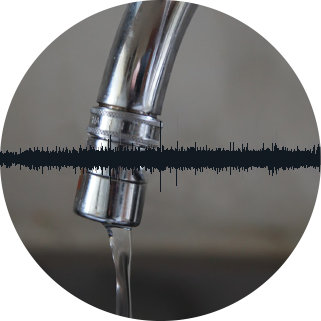Tuning in to Tingle
STORY BY SAM SUNDERLAND
photos by Annmarie Kent | infographics by Rachel Simons
Experiencing ASMR
Sounds that feel good — they’re different for everyone that feels the tingly sensation of ASMR. Fingers clicking away on a keyboard, brushes slowly moving down the back of a hand, fingers scratching at the spine of a book, hair rustling through hands, food mushing around in mouths, whispering voices and many other small, seemingly insignificant sounds may go unnoticed by the majority and felt by only some.
These sound triggers send tingles down Nataly Scheidt’s spine, traveling swiftly up to her head and culminating in an all-over calming sensation.
Scheidt first noticed this feeling during class in middle school. The scribble of a pen on paper and the click, click, click of a mechanical pencil instantly put her body at ease. She wasn’t aware of it then, but the feeling was a reaction called ASMR, Autonomous Sensory Meridian Response — the tingly, pleasurable sensation felt at the back of the neck, scalp or spine in response to certain visual and auditory stimuli.
Once community-generated websites such as Reddit and YouTube began talking about these sensations, a culture developed wherein thousands of videos have been made recreating visual and audio triggers with millions of views and hundreds of subscribers tuning in to tingle.
Scheidt and fellow linguistics major Brooks Donohue, both Western seniors, watch ASMR videos while doing homework or relaxing before they fall asleep.

The sound frequency of pencil on paper.
During college, both Donohue and Scheidt discovered ASMR videos while browsing Reddit. Under the SubReddit R/ASMR, titled “Sounds that feel good,” viewers can watch and discuss videos that cater to their specific triggers.
Each video is tagged to indicate whether the video’s creator intended for it to be an ASMR trigger or whether it was an unintentional trigger. Videos tagged “intentional” often portray ASMR artists that will sometimes whisper into their camera while they talk about their day or in some cases show off their makeup collection. Sometimes, ASMR artists role-play events or scenarios that are common triggers, such as a scalp massage or haircut.
Unintentional videos are videos already made that trigger ASMR in viewers. Known for his soft voice and relaxing videos, late scenic painter and “The Joy of Painting” television host Bob Ross has become a popular unintentional ASMR artist.
Scheidt says collection videos, in which an ASMR artist slowly talks about their collection of video games, books and more, are popular among the ASMR community. However, she prefers video game ASMR videos. During these videos, the sounds of clicking buttons and typing on a keyboard relax Scheidt into an almost slumber.
The pitch of a female ASMR artist’s voice triggers Scheidt more than a male voice, though for Donohue it’s the opposite. Donohue’s favorite ASMR video is mostly auditory — a binaural head massage video that states in the title “Wear Headphones!” Still pictures of shampoo, towels and candles take up the screen.
The video begins with a paper dressing sheet rustling as if the artist places it around the viewer’s neck, then the faucet turns on and water comes gushing out, as if it’s right in the viewer’s ear. A shampoo bottle clicks open and out squirts shampoo. The massage happens during the next few minutes — hair scrunches as shampoo mixes with water, fingers scratch against the scalp, then the water runs to rinse it all off.

The sound frequency of a clicking keyboard.
Donohue listens, with headphones secured, as the sounds send tingles between his ears, then down his spine like rushes of electricity.
Many people do not feel anything listening to these videos, and even more have never heard of ASMR. some her friends have given the videos a chance, but others think they’re just plain weird, Sheidt says.
So what does experiencing ASMR mean and why doesn’t everyone experience the sensation?
Steven Novella, a clinical neurologist and professor at Yale University School of Medicine, believes that although there is little research behind the concept, it doesn’t mean it doesn’t exist. Similar to migraine headaches, many people report the same symptoms and feelings although there is no definitive answer to whether it’s a true phenomenon.
For Karissa Burnett, a second year Clinical Psychology Ph.D. student, which wasn’t enough.
The Fuller Graduate School of Psychology student first remembers experiencing ASMR in second grade while her teacher was reading “The Cat in the Hat” aloud to the class.
“I called it ‘the feeling’ and have experienced it ever since,” Burnett says in an email.

The sound frequency of running water.
Burnett found the ASMR community after randomly deciding to search for the “tingly and calm feeling” online while procrastinating on a class assignment.
Discovering ASMR was an enlightening experience for Burnett. Following her passion for scientific inquiry, she decided to join Dr. Craig Richard of Shenandoah University and Jennifer Allen, who Burnett says coined the term ‘ASMR,’ to lead research efforts studying those who do and do not experience ASMR.
Those who do not experience ASMR are skeptical, which Burnett says is expected with any new area of research. So far, the ASMR community has been eager and willing to participate in the study, Burnett says.
“They are excited to see it taken seriously and to uncover its origins,” she says.
Experiencing ASMR can be summed up as a “tingly sensation from sounds and experiences,” though there is currently no scientific research to qualify the phenomenon as anything more than a feeling. Whispering voices and brushes against skin might send chills down hundreds of YouTube subscribers’ spines, but until more scientific explanation emerges, ASMR will remain an unexplained sensory experience.